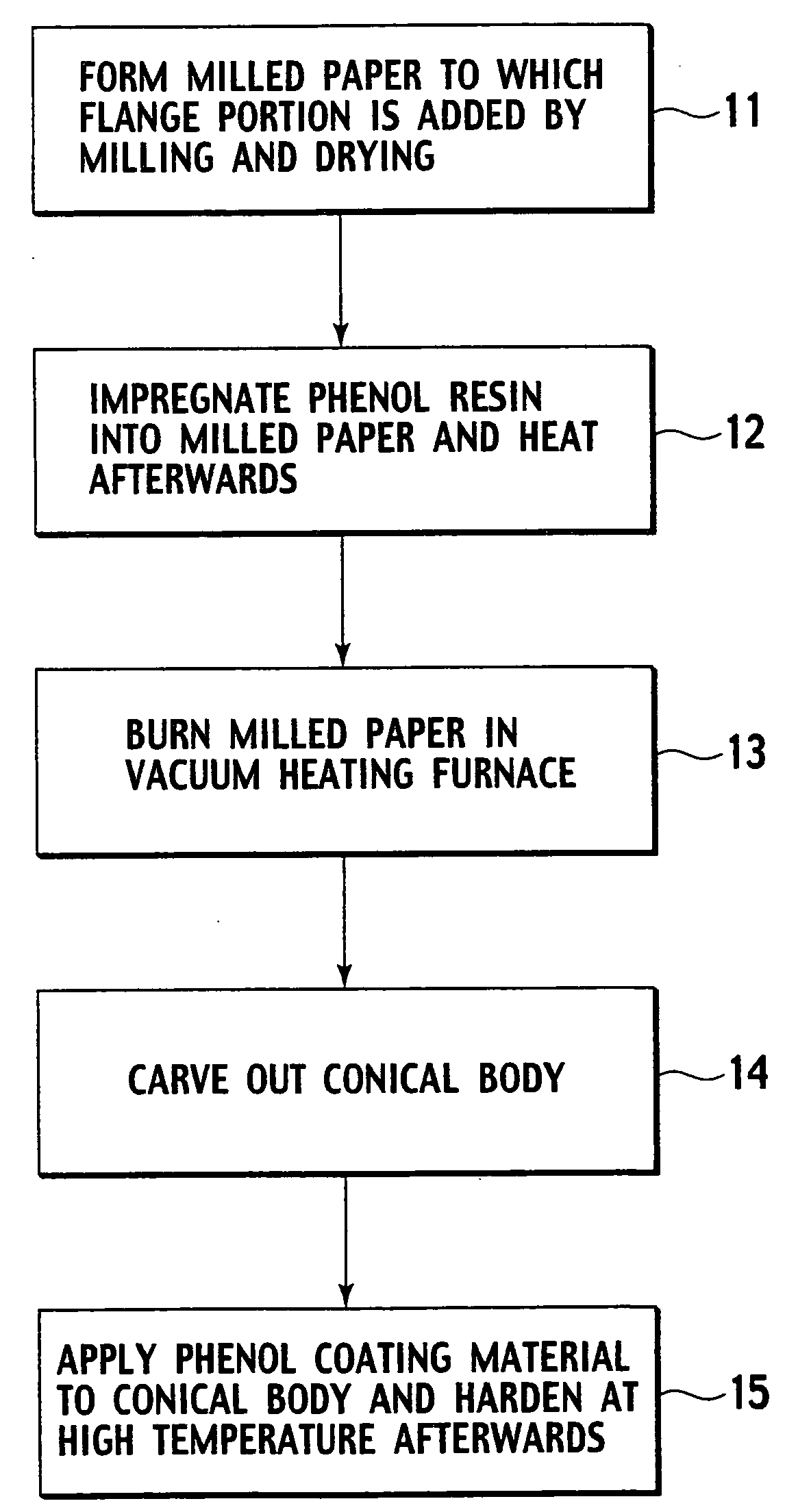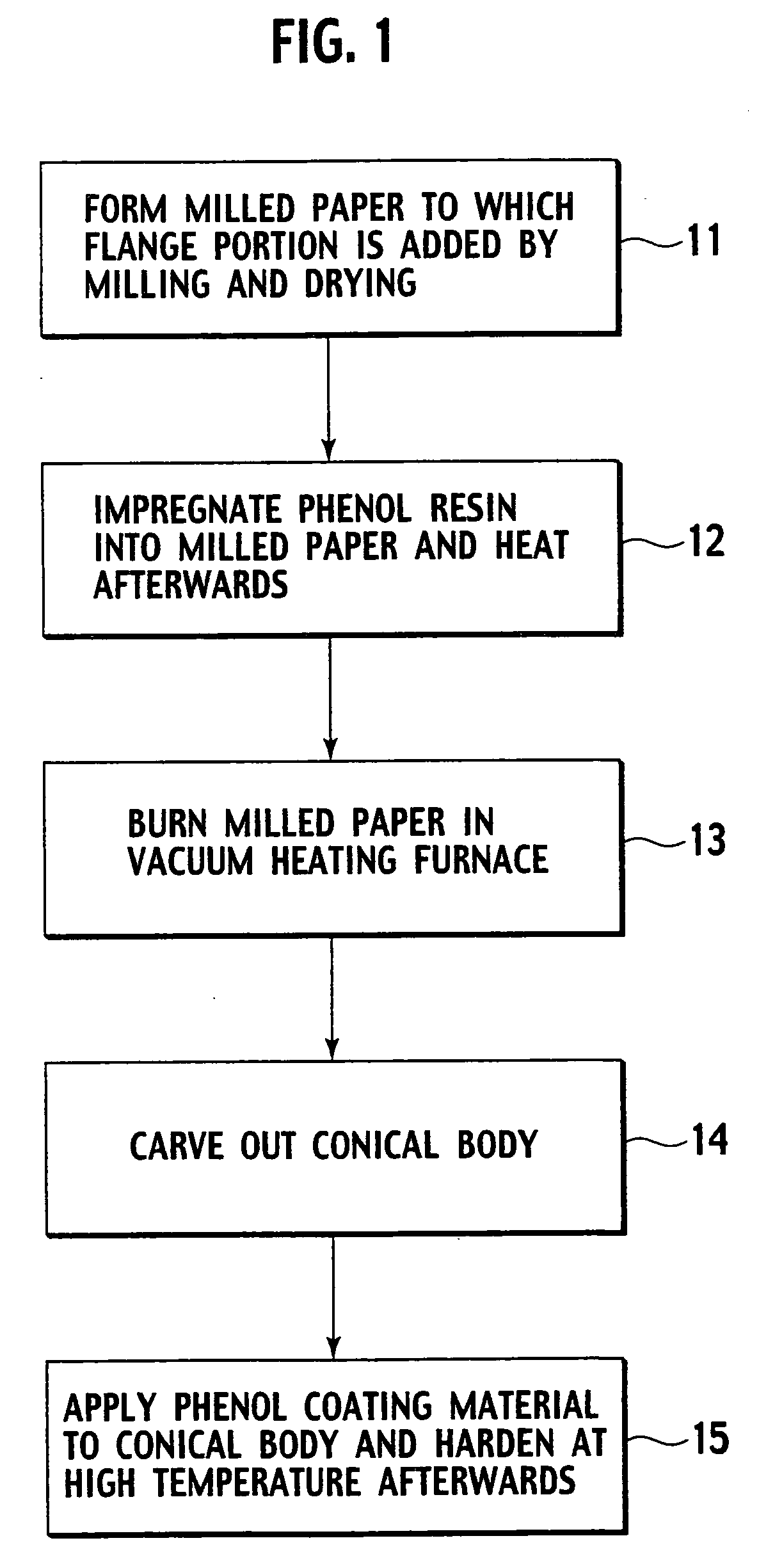Production method of an acoustic diaphragm, acoustic diaphragm, and a speaker
a production method and technology of acoustic diaphragm, applied in the direction of fiber diaphragm, transducer diaphragm, instruments, etc., can solve the problems of air leakage, sound deterioration, sound deterioration, etc., to reduce the viscosity, increase permeability, and slow the hardening
- Summary
- Abstract
- Description
- Claims
- Application Information
AI Technical Summary
Benefits of technology
Problems solved by technology
Method used
Image
Examples
first embodiment
[0045]A first embodiment of the present invention will be described. FIGS. 1 and 2A to 2F are explanatory diagrams of a production method according to the first embodiment.
[0046]At a first step 11 in FIG. 1, as shown in FIG. 2A, a previously formed mesh 101 having a center portion has a conical shape (truncated shape) is prepared. (Since the workpiece contracts due to a burning operation, the mesh may be formed larger than the size of the workpiece after the burning operation. For example, when it is heated at 800° C., contraction of, for example, 25% in the longitudinal direction is taken into consideration, and the mesh is formed larger by this value.) The mesh 101 is put into a dispersion liquid 102 into which mixture fiber of 90 wt % of linter (cotton fiber) 10 wt %+NBKP [Needle Bleach Kraft Pulp] (softwood fiber is made into pulp by the kraft process and is further bleached) is dispersed, and the mixture fiber is milled into paper on the mesh 101. A reference number 103 in FIG....
second embodiment
[0057]FIGS. 4 and 5A to 5G are explanatory diagrams of a production method according to the second embodiment.
[0058]At a first step 21 in FIG. 4, as shown in FIG. 5A, a previously formed mesh 201 having a center portion has a conical shape (truncated shape) is prepared. (Since the workpiece contracts due to a burning operation, the mesh may be formed larger than the size of the workpiece after the burning operation. For example, when it is heated at 800° C., contraction of, for example, 25% in the longitudinal direction is taken into consideration, and the mesh is formed larger by this value). The mesh 201 is put into a dispersion liquid 202 into which mixture fiber of 90 wt % of linter (cotton fiber) 1 wt %+NBKP [Needle Bleach Kraft Pulp] (softwood fiber is made into pulp by a kraft process and is further bleached) is dispersed, and the mixture fiber is milled into paper on the mesh 201.
[0059]A reference number 203 represents a suction direction when paper is milled, and a referenc...
third embodiment
[0071]FIGS. 6 and 7A to 7H are explanatory diagrams of a production method according to a third embodiment.
[0072]At a first step 31 in FIG. 6, as shown in FIG. 7A, a previously formed mesh 301 having a center portion into a domical shape (hemispherical shape) is prepared. (Since the workpiece contracts due to a burning operation, the mesh may be formed larger than the size of the workpiece after the burning operation. For example, when the it is heated at 800° C., contraction of, for example, 25% in the longitudinal direction is taken into consideration, and the mesh may be formed larger by this value). The mesh 301 is put into dispersion liquid 302 into which mixture fiber of 90 wt % of linter (cotton fiber) 10 wt %+NBKP [Needle Bleach Kraft Pulp] (softwood fiber is made into pulp by kraft process and is further bleached) is dispersed, and the mixture fiber is milled into paper on the mesh 301. A reference number 303 represents a suction direction when paper is milled, and a refere...
PUM
 Login to View More
Login to View More Abstract
Description
Claims
Application Information
 Login to View More
Login to View More - R&D
- Intellectual Property
- Life Sciences
- Materials
- Tech Scout
- Unparalleled Data Quality
- Higher Quality Content
- 60% Fewer Hallucinations
Browse by: Latest US Patents, China's latest patents, Technical Efficacy Thesaurus, Application Domain, Technology Topic, Popular Technical Reports.
© 2025 PatSnap. All rights reserved.Legal|Privacy policy|Modern Slavery Act Transparency Statement|Sitemap|About US| Contact US: help@patsnap.com



